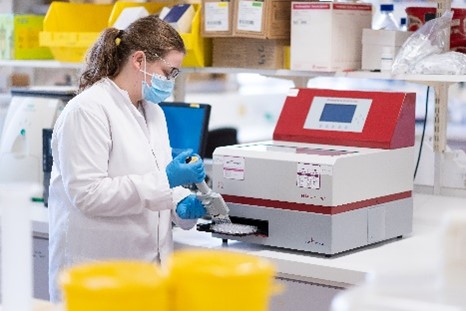Case Study - Rebecca Davies

Tell us about yourself
My name is Rebecca Davies and I am a third year PhD student working towards ‘the large-scale production of umbilical cord mesenchymal stromal cell extracellular vesicles (EV) for the treatment of rheumatoid arthritis’ at the University of Keele as part of a CDT in Regenerative Medicine.
Can you give us an overview of your project?
My project focusses on trying to recapitulate the immunomodulatory properties of mesenchymal stromal cells by isolating their extracellular vesicles – small (<200nm), membrane bound particles that are packed with RNA and protein. Here, we are trying to increase yields for research and therapeutic applications and are applying them to models of RA, including murine models of arthritis and RA patient immune cells, to determine their effectiveness as a potential treatment.
How did the seedcorn access help?
The field of extracellular vesicles encourages use of imaging to determine what has been isolated from your vesicle preparation to determine vesicle morphology and identify any unwanted co-isolates. Seedcorn Access provided me with an opportunity to use electron microscopy (EM) facilities that are not available at Keele University. Furthermore, we are inexperienced in the field of EM and this scheme connected us with an expert who could provide this knowledge and expertise.
How did you hear about the seedcorn access?
We heard about Seedcorn Access after applying to a similar scheme called ‘TALENT’. Upon notice of our lack of success to use the University of Warwick’s EM facilities through this scheme, we were encouraged to resubmit the application to an internal University scheme through which we were successful.
How was the application process?
The application process was very simple. After finding the correct departmental contact you can gain the opinion of the expert to estimate the hours needed for the facility, who will later be very happy to check over your application. This consists of a one-page document with context, methodology and justification of the project.
What were the outcomes?
Cryo-EM has allowed us to identify membrane bound structures to confirm EV enrichment using our protocols and fulfil minimal criteria within this field. Furthermore, these EVs are the expected size (<200nm) and display the variable phenotypes of EVs seen in the literature; single vesicles, double vesicles, multivesicular bodies, coated and pleomorphic vesicles.
What would you have done without the seedcorn access?
Without Seedcorn Access we likely would have needed to use a service that provides EM preparation and imaging within our budget. This likely would have been Transmission EM (TEM) that is not optimal for imaging vesicles as the processing of the samples does not preserve them in their natural state and produces a ‘cup-like morphology’ that warps sizing and makes clear identification difficult.

